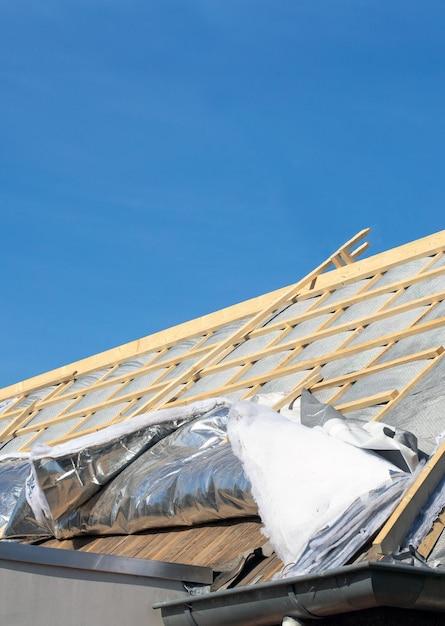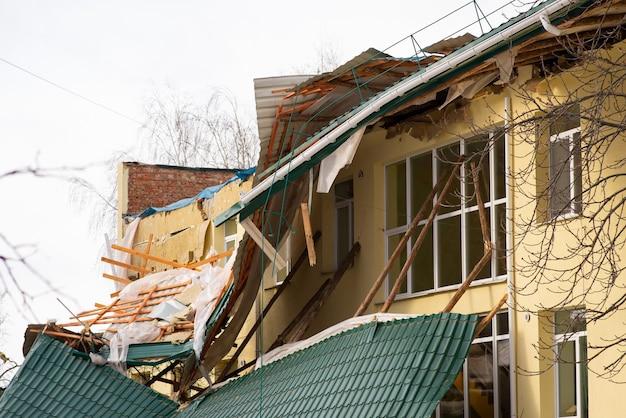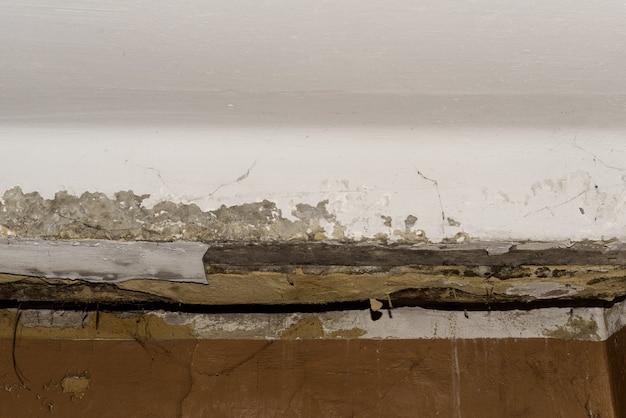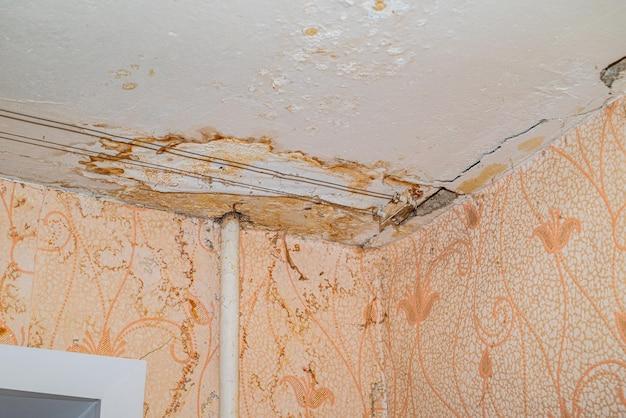Have you been experiencing roof problems lately? Are there unexplained leaks, drooping ceilings, or visible cracks? These could be signs of a termite infestation, which is one of the worst nightmares any homeowner could face. Termites are notorious for causing massive damage to wooden structures, and roofs are no exception. In this blog post, we will explore everything you need to know about termite roof damage, starting with what it is, the signs to look out for, and what to do if you suspect you have an infestation. So, sit back, grab a cup of coffee, and let’s dive in!
Types of Termite Roof Damage
If you’re a homeowner, you’ve probably seen your fair share of house damage, from leaky faucets to clogged gutters. But have you ever had to deal with termite roof damage? These pesky, wood-munching insects can cause serious harm to your roof and your bank account.
What are Termites
Before we dive into the types of termite roof damage, let’s first talk about termites themselves. Termites are small, white or brown insects that live in colonies. They feed on wood, and they can cause serious damage to your home if left unchecked.
How do Termites Damage Roofs
Termites typically enter a home through the foundation or walls, but they can also gain access to your roof. Once they’re up there, they’ll start eating away at any wood they can find. This can cause structural damage to your roof and weaken it over time.
Common Types of Termite Roof Damage
There are three main types of termite roof damage to watch out for:
1. Structural Damage
As mentioned earlier, termites can cause serious structural damage to your roof. This can lead to leaks, collapsing roofs, and other safety hazards.
2. Cosmetic Damage
Termites can also cause cosmetic damage to your roof. This might include holes or cracks in your shingles, or even a sagging roofline. While this type of damage might not compromise the structure of your roof, it can still be unsightly and affect your home’s value.
3. Insulation Damage
Finally, termites can damage the insulation in your roof. This might not sound like a big deal, but it can lead to higher energy bills and other problems down the line.
Preventing Termite Roof Damage
So, how can you prevent termite roof damage in the first place? Here are a few tips:
- Keep your gutters clean and your roof free of debris
- Trim any trees or bushes that are touching your roof
- Patch up any cracks or holes in your roof
- Get regular termite inspections from a pest control professional
By following these simple steps, you can keep your roof safe from termites and ensure that your home stays in great shape for years to come.
Signs of Termites in the Roof
If you’re seeing some small insects in your home, you might just ignore them and think they’ll go away. But termites can be a real problem that only gets worse if left unchecked. One of the places termites love to destroy is your roof. Here are some signs that your roof may be infested with termites.
Sawdust or Frass
If you’re seeing a pile of sawdust or frass lying around your roof, then it’s a sure sign of a termite infestation. This is because termites will burrow through the wood, leaving behind their excrement and nest materials in piles.
Soft Wood
If you suspect that your roof may be infested with termites, simply tap the wood with a hammer or flat object to listen for a hollow sound. If the wood sounds hollow and feels soft, then it is a sign of termite damage.
Peeling Paint or Blisters
If you’re seeing peeling paint or blisters on your roof, it could be a sign of termite activity. This is because termites produce moisture as they burrow through the wood, which can cause the paint to blister or peel off.
Visible Termites
If you’re seeing visible termites around your home, then it’s a sign that they’ve already made themselves at home in your roof. You may see them in small, white ant-like swarms or clusters.
Uneven or Sagging Roof
If your roof seems to be sagging or uneven, it could be because termites have weakened the wood structure. If you see this, contact an experienced pest control professional immediately.
As you can see, there are some clear signs that your roof may be infested with termites. If you suspect that you have a problem, don’t hesitate to contact a professional to solve the issue. With prompt action, you can protect your home before significant damage is done.
Examples of Termite Damage
Termite damage can range from mild to severe, and it’s essential to identify the signs early before it’s too late. Here are a few examples of what to look out for if you suspect termite damage:
Hollow Sounds
If you hear any hollow sounds when you tap the wooden structures in your home, it could be a sign of termite damage. Termites eat wood from the inside out and leave only thin layers of wood on the surface. This makes the wooden structures brittle and fragile, leading to a hollowed-out appearance.
Buckling Floors
If your floors are starting to buckle or appear warped, it could be a sign of termite damage. Termites can chew through wooden beams and supports in the subflooring, causing them to weaken and creating an uneven appearance on the surface.
Crumbling Wood
If you notice any crumbling or flaking wood around your home, it could be a sign of termite damage. Termites will eat the cellulose present in the wood, causing it to become brittle and weak. Eventually, the wood will start to crumble and fall apart, leaving behind only crumbs and debris.
Sagging Ceilings
If the ceilings in your home appear to be sagging or feel weaker than usual, it could be a sign of termite damage. Termites can eat through wooden ceiling joists and supports, causing them to weaken and sag over time. This can create a dangerous situation as the ceiling could collapse if left unchecked.
Discolored Walls
If you notice any dark or discolored areas on your walls, it could be a sign of termite damage. Termites will eat through the wooden studs and supports in your walls, leaving behind trails of mud and debris. These trails can create discolored areas on your walls, indicating the presence of termites.
Termites can cause significant damage to your home, so it’s important to take action as soon as possible. By knowing the signs of termite damage, you can identify any problems early and prevent them from getting worse. If you suspect termite damage, don’t hesitate to call in a professional to assess the situation and recommend a course of action.
Termites in Ceiling Drywall
If you thought termite damage is limited to the roof, you might want to think again. Termites are notorious for not sticking to one spot and can spread to other areas of your home. One of those areas could be your drywall ceiling. In this subsection, we’ll explore the nasty ways termites can invade and damage your ceiling drywall.
What Are Termites Doing in My Ceiling Drywall
Termites love moisture and are always on the hunt for it. Your ceiling drywall is a prime target for termites due to the moisture content it holds. Termites can tunnel their way through the drywall and feast on the cellulose present in the material. Over time, the damage can become extensive and can weaken the overall structure of your ceiling.
How Do I Know If I Have Termites in My Ceiling Drywall
Detecting termites in your ceiling drywall can be a bit tricky since most of the damage is happening behind the scenes. However, there are a few telltale signs to look out for. Look for any sagging or drooping in your ceiling. Also, check for any cracks or holes in the drywall. If you observe any of these signs, there might be termites present in your drywall.
Can I Prevent Termites from Invading My Ceiling Drywall
Yes, you can prevent termites from invading your drywall. The best way to do this is by keeping your home as dry as possible. Repair any leaks in your roof or plumbing as soon as you detect them. Keep your home adequately ventilated, and ensure there is no standing water around your house. Additionally, you can have a professional inspect your home annually to identify and treat termite infestations.
In conclusion, termites are stealthy creatures and can cause extensive damage to your ceiling drywall if left unchecked. Being aware of the signs of termite damage and taking preventative measures is crucial in preserving the integrity of your home. If you suspect termites are infiltrating your drywall, contact a professional to help you get rid of them before the damage becomes irreversible.
Termite Roof Damage Treatment
If you’ve discovered termite roof damage, the good news is that it’s generally treatable. Here’s what you need to know about treating termite roof damage:
Inspection
First and foremost, you need to identify the extent of the damage before you can move on to the treatment stage. This is where you’ll want to call in a professional inspector, and preferably one with experience in treating termite roof damage.
Treatment Options
Once you’ve identified the damage, you’ll need to decide on the best course of treatment. This will depend on the severity of the damage and the materials used in your roof. Treatment can range from sealing up cracks and crevices to replacing entire roof sections.
DIY vs. Professional Treatment
You may be tempted to try a DIY approach to termite roof damage treatment, but we highly recommend against it. Without the expertise or equipment necessary, attempting to treat termite roof damage yourself can be dangerous and lead to further damage. It’s always best to bring in a professional for these types of repairs.
Prevention
Finally, once your roof has been repaired, it’s important to take steps to prevent future termite damage. This can include regular inspections, treating surrounding areas for termites, and keeping your roof clean and well-maintained.
Don’t let termite roof damage get you down. With the right treatment and prevention measures, you can repair your roof and avoid future problems. Just remember to call in the professionals and take precautions to keep those pesky termites at bay.
How to Fix Termite Roof Damage
So, your roof has been invaded by termites, and you’re wondering how to fix the damage they’ve caused? Fear not, my friend, for help is at hand! Here’s a step-by-step guide on how to restore your roof to its former glory:
Step 1: Identify The Damage
Before you can fix anything, you need to know what you’re dealing with. So go up onto your roof (safely, of course) and inspect it for any damage caused by termites. Look out for any holes or cracks in the roof, as well as any signs of termite activity such as mud tubes.
Step 2: Get Rid of the Termites
You can’t fix the damage if termites are still running around, causing havoc. So, you need to eradicate them from your roof. Call in an exterminator to spray the affected area with termite-killing chemicals. Or, if you are feeling brave, you can try a DIY approach – just be sure to follow the instructions on the pesticide container carefully.
Step 3: Fix The Damage
Once the termites have been eliminated, it’s time to start fixing the damage. Start by filling any holes or cracks with a filler material. Then, replace any damaged tiles or shingles on the roof. If the damage is extensive, and you’re not confident in your DIY skills, it may be best to call in a roofing contractor to do the job.
Step 4: Prevention is Key
Termites love wood, which means that your roof is a prime target. To prevent any future infestations, it’s important to take preventative measures. Keep any trees trimmed to prevent them from touching the roof and ensure any wooden parts of your home are treated with termite repellent.
In conclusion, fixing termite damage to your roof is not impossible, but it does require some effort and expertise. By following these steps, you should be able to restore your roof to its former glory and prevent any future infestations. So put on your toolbelt and get to work – your roof will thank you!
Can a Roof Collapse from Termites
If you’re currently reading this, you’re probably in a state of panic, wondering, “Can a roof really collapse from termites?” Well, we hate to break it to you, but the answer is yes.
The Culprits
Termites are small insects that silently and stealthily eat away at the wooden structures in your home. They particularly love to feed on cellulose, which is present in wood, paper, and fabrics. Unfortunately, your roof is made of wood, making it an attractive feast for these pesky insects.
The Damage
As they munch on your roof beams, the structural integrity of your roof becomes compromised. Over time, your roof will start to sag, crack, and eventually collapse if left untreated. Plus, termites work quickly and efficiently, so even a small infestation can cause significant damage in a short amount of time.
The Signs
Signs of termite damage on your roof can include tiny holes in the wood, crumbling plaster, and droppings on your ceiling. If you notice any of these warning signs, it’s best to take immediate action and call a pest control professional to assess the damage and develop a treatment plan.
Prevention is Key
The best way to prevent roof collapse from termites is to take a proactive approach. Regularly inspecting your roof for termite damage and treating any infestations immediately can help prevent costly damage and ensure the safety of your home.
In conclusion, while the thought of a roof collapse from termites may be a scary one, it is a very real possibility if left untreated. Don’t let these pesky insects damage your beautiful home; take action now to prevent termite infestations and ensure the longevity of your roof.
Is Termite Damage Covered by Insurance
If you’ve just found out that termites have wrecked your roof and you’re wondering if your insurance company can help you cover the repair cost, don’t worry – you’re not alone. Many homeowners have found themselves in this situation.
The Not-So-Good News
Unfortunately, the answer to this question is not as straightforward as we would want it to be. In many cases, termite damage is not covered by regular home insurance policies because it’s considered a result of poor maintenance, which is a homeowner’s responsibility.
The Good News
However, there is some good news. If your home insurance policy includes an “additional coverage” clause, it may cover termite damage. Other factors like the cause and extent of damage can also influence the outcome of your claim.
What to Do Next
So, if you suspect that your roof damage is caused by termites, the first thing you should do is to contact your insurance company and ask them about their coverage policy. You may need to provide proof of the cause of the damage, such as hiring a professional exterminator to inspect your roof.
Prevention is Better Than Cure
Of course, prevention is always better than cure. To avoid incurring a hefty repair cost, it’s important to regularly inspect your roof for signs of termite damage, such as soft spots, cracks, and small holes. You can also take preventive measures, like treating your roof with anti-termite chemicals and sealing cracks and openings.
In conclusion, termite damage is not always covered under regular home insurance policies, but there are ways to get coverage. To avoid any misunderstandings and confusion, be sure to read and understand your home insurance policy carefully. Don’t hesitate to ask if you’re not sure about something. And, as always, prevention is the best way to avoid costly repairs.
What to Do When You Have Termite Damage
You noticed some suspicious holes in your roof, and after inspection, you discovered that termites have caused significant damage to your roof’s structure. Your first instinct is probably to panic or wonder how you’ve let this happen. But don’t worry, here are some steps you can take to address this issue.
Assess the Damage
Before you start any repair or removal, you need to determine the extent of the damage. You may need to hire a professional to inspect and evaluate the situation and provide you with an estimate. This step could help you avoid further damage to your property—better safe than sorry, right?
Eliminate the Infestation
Once you determine the extent of the termite damage, it’s essential to get rid of them so they won’t cause any further harm to your home. You can remove them yourself using DIY methods, or you could contact a professional pest control company. Always consider the costs and your personal preferences before making any decisions.
Repair the Damage
Once the termites have been eliminated, it’s time to repair the damage. Depending on the extent of the damage, the repairs might require significant changes in your roof’s structure. Don’t ignore this step as it’s crucial to ensure the structural integrity of your roof and your safety. Remember that the cost of repairs will vary depending on the extent of the damage, the materials used, and whether you decide to hire professional services or DIY.
Prevent Future Infestations
You don’t want to go through this again, so it’s essential to take the necessary precautions to prevent future termite infestations. You could use pesticides, treat the wood using chemical preservatives, install physical barriers to block termites from entering, or use specific construction techniques that make it more challenging for termites to enter.
Termites can cause a significant amount of damage to your roof and home, but don’t panic. Now that you know what to do when you have termite damage, you can take the necessary actions to address the issue and prevent future infestations. Addressing termite damage promptly could save you lots of headaches and expenses in the future.
What Does Termite Damage Look Like in Ceiling
Termite damage in a ceiling isn’t always easy to identify, but there are some tell-tale signs to look out for. Here are some signs that your ceiling might have termite damage:
Small Holes
Termites burrow through wood, creating small holes and tunnels. If you notice small holes in your ceiling, it could be termites at work. Don’t worry, it’s not the end of the world, but you will need to take action to prevent further damage.
Sagging Ceiling
One of the most visible signs that your ceiling has termite damage is when it starts to sag. The termites can weaken the wood fibers, making the wood less strong and more prone to sagging.
Musty Smell
Termites produce a musty odor that can sometimes be detected in the ceiling if the infestation is severe. If you notice a musty smell, it might be time to call in an exterminator to assess the damage.
Buckling or Peeling Paint
If the paint on your ceiling looks like it’s buckling or peeling, it could be a sign of termites. The termites can cause the paint to become distorted as they burrow through the wood.
Visible Tunnels
Sometimes, you can actually see the tunnels that termites create in the wood. If you notice any visible tunnels in your ceiling, it’s time to take action.
Overall, termite damage in a ceiling can be difficult to spot, but there are some signs to look out for. If you notice any of the signs mentioned above, make sure to call in a professional to assess the situation and take action to prevent further damage. Don’t let those pesky termites take over your beautiful ceiling!
How Do You Know if You Have Termites in the Roof
Welcome to the most thrilling subsection of this article! Look, we all know you’re here because you suspect you have termites in your roof, but you’re not entirely sure. Don’t panic; I’m here to give you all the telltale signs that you have those tiny, annoying, and stubborn creatures living in your roof rent-free.
Mud Tubes
One of the most common signs of termite invasion in a roof is the presence of mud tubes. These brown, pencil-sized tunnels, usually found on the exterior walls of the house, are the termites’ highways between their nest and the wood they feed on. So, if you spot mud tubes anywhere on your roof or walls, it’s a sign that termites are probably around.
Holes in the Wood
Termites are notorious for chewing up wood structures, and your roof is no exception. Check your roofline, eaves, fascia, and rafters for tiny holes, or hollow-sounding wood, as this might indicate termite activity.
Visible Termites
Well, this one is pretty obvious. If you happen to see tiny, pale-colored, and winged insects flying around your roof, that’s a good sign you have termites. They usually swarm around the house during springtime, and they’re attracted to light. So, be sure to keep the porch light off if you’re trying to avoid them.
Termite Droppings
Termite frass (droppings) looks like tiny wood pellets and is often found around the areas where termites infest. If you find these in your attic or see piles of them around your roof, then there’s a high chance that termites have made themselves at home.
Sagging Roof
If your roof suddenly starts sagging or buckling in some areas, chances are you have termite damage. When termites damage the structural wood framework of your roof, it weakens the roof’s overall integrity and causes it to sag or buckle.
There you have it, folks! Now you know how to spot those pesky little termites before they cause significant damage to your roof. Remember, if you suspect termites have invaded your roof, call a professional pest control company immediately.
How Long Does it Take for Termites to Cause Structural Damage
Termites are the silent destroyers. They’re like the ninjas of the insect world, sneaking up on your home and destroying it from the inside out. But how long does it take for these little terrors to cause structural damage?
The Slow Burn
The bad news is that termites can take a while to cause structural damage. The good news is that it’s not immediate. Think of it like a slow burn. The termites will slowly eat away at the wood in your home, causing damage over time.
It Depends on the Colony
The time it takes for termites to cause structural damage depends on the size of the termite colony. A small colony may take several years to cause significant damage, while a larger colony can cause serious structural damage in as little as six months.
Don’t Wait for the Signs
The problem with termite damage is that it’s not always easy to see. By the time you notice signs of termite damage, it’s often too late. Don’t wait for the signs. Be proactive and have your home inspected for termites regularly.
Prevention is Key
The best way to prevent termite damage is to make your home less attractive to termites. This includes fixing any leaks in your home, keeping your gutters clean, and removing any wood debris from your yard.
In conclusion, termites can cause structural damage, but it’s not an immediate threat. The time it takes for termites to cause damage depends on the size of the colony. The best way to prevent termite damage is to be proactive and make your home less attractive to termites. Remember, prevention is key!



